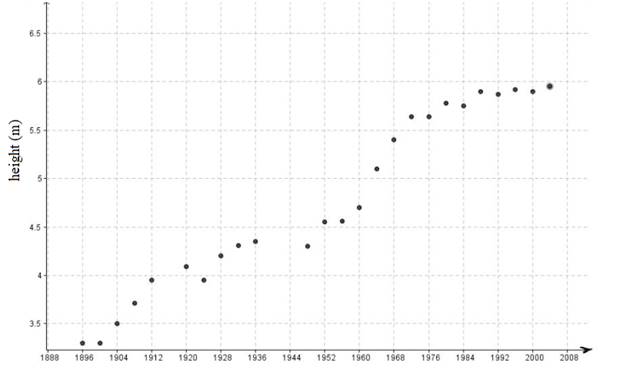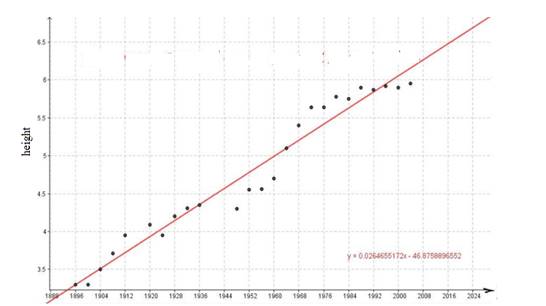
Concept explainers
a.
To make: a
a.
Answer to Problem 23E
Yes, a linear model is appropriate in the scatter plot.
Explanation of Solution
Given:
The given table shows the winning heights for the Olympic pole vault competitions up to the year 2020.
| Year | Height (m) | Year | Height (m) |
| 1 | 3 | ||
Calculation:
The scatter plot of the data is shown below:

The points in the scatter plots follows a linear trend, so it is appropriate to use a linear model to describe this situation.
b.
To find: the graph and regression line.
b.
Answer to Problem 23E
Explanation of Solution
Given:
The given table shows the winning heights for the Olympic pole vault competitions up to the year 2020.
| Year | Height (m) | Year | Height (m) |
Calculation:
According to the table, to make a linear regression line and obtained the equation:
Now, graph of the regression line is shown below

Hence, a linear regression line model is
c.
To predict: the height of the winning pole vault at 2004 Olympics and compare with actual winning height of 5.95 meters.
c.
Answer to Problem 23E
Explanation of Solution
From part (b)
Chirping rate is
Calculation:
The regression line of the equation is
The objective is to estimate the height for 2008 Olympics,
Plug
According to the linear model the winning height in 2008 Olympics should be close
It seems the model overvalued the winning height in 2008.
d.
To check: that it is reasonable to apply the model to predict the winning height at the 2010 Olympics.
d.
Answer to Problem 23E
It is not reasonable.
Explanation of Solution
Given:
The given model is
Calculation:
Plug the value of
It is hard to believe these athletes will be able to jump outstanding height of 8 meter.
Chapter 1 Solutions
Single Variable Calculus: Concepts and Contexts, Enhanced Edition
 Calculus: Early TranscendentalsCalculusISBN:9781285741550Author:James StewartPublisher:Cengage Learning
Calculus: Early TranscendentalsCalculusISBN:9781285741550Author:James StewartPublisher:Cengage Learning Thomas' Calculus (14th Edition)CalculusISBN:9780134438986Author:Joel R. Hass, Christopher E. Heil, Maurice D. WeirPublisher:PEARSON
Thomas' Calculus (14th Edition)CalculusISBN:9780134438986Author:Joel R. Hass, Christopher E. Heil, Maurice D. WeirPublisher:PEARSON Calculus: Early Transcendentals (3rd Edition)CalculusISBN:9780134763644Author:William L. Briggs, Lyle Cochran, Bernard Gillett, Eric SchulzPublisher:PEARSON
Calculus: Early Transcendentals (3rd Edition)CalculusISBN:9780134763644Author:William L. Briggs, Lyle Cochran, Bernard Gillett, Eric SchulzPublisher:PEARSON Calculus: Early TranscendentalsCalculusISBN:9781319050740Author:Jon Rogawski, Colin Adams, Robert FranzosaPublisher:W. H. Freeman
Calculus: Early TranscendentalsCalculusISBN:9781319050740Author:Jon Rogawski, Colin Adams, Robert FranzosaPublisher:W. H. Freeman
 Calculus: Early Transcendental FunctionsCalculusISBN:9781337552516Author:Ron Larson, Bruce H. EdwardsPublisher:Cengage Learning
Calculus: Early Transcendental FunctionsCalculusISBN:9781337552516Author:Ron Larson, Bruce H. EdwardsPublisher:Cengage Learning





